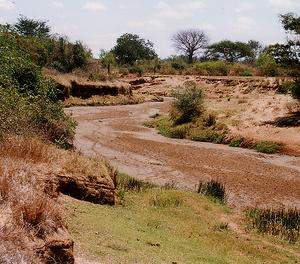53城市抽樣調查:8成灌溉用水不乾淨
 「世界水資源週」(World Water Week)活動18日於瑞典斯德哥爾摩展開,世界自然基金會(WWF)執行長李普(James Leape)在開幕儀式中表示,全球清潔淡水的供應量無法滿足人類當今奢侈浪費的使用方式,再加上水資源管理不善,造成了大多數國家糧食短缺、糧價上漲。
「世界水資源週」(World Water Week)活動18日於瑞典斯德哥爾摩展開,世界自然基金會(WWF)執行長李普(James Leape)在開幕儀式中表示,全球清潔淡水的供應量無法滿足人類當今奢侈浪費的使用方式,再加上水資源管理不善,造成了大多數國家糧食短缺、糧價上漲。
李普指出,「世界糧食危機的背後根源是全球淡水資源危機,隨著氣候變化的衝擊增強,水源危機也將迅速惡化。」他更表示,「全球糧食有45%由灌溉式農業生產,一旦失去灌溉式農業,將無法餵飽地球上的60億人口。」
世界許多灌溉區域都飽受威脅,從河川與地下水層汲取了過多的水源,若考慮氣候變化則問題更形嚴重,李普對此提出警告,並指出淡水水域供應的食物也正在減少,原因是加速興建水壩,以及河川取水量超出永續使用負載。
當前有數十億人缺乏安全用水,健康受到惡劣衛生條件的威脅,同時間糧食與生質燃料生產者又彼此爭奪土地與水源,水資源整體的平衡更在全球氣候變化中擺盪,為了以上諸多問題,本週有2千5百位水資源專家齊聚在斯德哥爾摩國際事務會議中心,共同擬定解決方針。
「世界水資源週」是斯德哥爾摩國際水資源中心籌辦的年度活動,今年會議的主題是「用水的進步與展望: 以衛生為焦點,打造一個乾淨健康的世界」,與聯合國指定2008為國際衛生年互相呼應。

肯亞乾涸的河流(照片來源不明)
從1970年代開始,發展中國家經歷全球糧食危機,用水也出現前所未有的短缺。根據國際水資源管理中心(IWMI)於會議中發表的最新結果,在53個接受調查的城市中,有8成的農業灌溉水源是未經處理或僅部份處理過的廢水。
調查報告結果的首席作者是IWMI研究員瑞絲綺莎麗(Liqa Raschid-Sally),她表示,「在一些貧窮國家,用廢水灌溉並不少見。這個現象在開發中地區很普遍,影響2千萬公頃的農田,特別是在亞洲,包括中國、印度與越南,但是在非洲次撒哈拉地區,幾乎所有城市都是如此,拉丁美洲很多城市也一樣。」
根據IWMI的這份報告與其他調查,廢水最常被用來灌溉蔬菜及穀物,尤其是稻米。這對消費者,特別是生食蔬菜的民眾造成健康威脅,益發令人憂心。
53個城市的消費者都希望能避免買到廢水澆灌的農產品,但對於市面上產品的來源,消費者卻難以知悉。報告也顯示,農民其實知道使用廢水灌溉會威脅自己和購買者的健康,但因為安全的地下水不易取得,他們往往別無選擇。
報告內容也強調一些在地居民使用的方法,可以減少廢水灌溉農業的健康隱憂。以印尼、尼泊爾、迦南與越南為例,農民會將廢水先儲存在池塘中,讓固態懸浮物質能夠沈澱。
缺少適當廢水處理系統的國家,還是可以使用低成本的中繼處理方式,例如使用滴水灌溉法( drip irrigation),以及清水洗淨新鮮農產品等,來減輕廢水對健康的威脅。
WWF執行長李普指出,在全球水資源中有97.5%是鹹水,其餘的淡水大多以冰的形式存在,只有1%是人類可方便取用的。他表示,「儘管淡水比例如此稀少,如果水循環能適當運作,而我們能以智慧管理水源,仍然足以供應全人類生存使用。」
但李普也向與會代表發出警訊,目前全球對用水危機惡化所作的準備遠遠不足,原因是氣候變化所造成的衝擊,而目前對淡水資源的管理又未將生態系統納入考量。
The world's supplies of clean, fresh water cannot sustain today's "profligate" use and inadequate management, which have brought shrinking food supplies and rising food costs to most countries, WWF Director General James Leape told the opening session of World Water Week in Stockholm today.
"Behind the world food crisis is a global freshwater crisis, expected to rapidly worsen as climate change impacts intensify," Leape said. "Irrigation-fed agriculture provides 45 percent of the world's food supplies, and without it, we could not feed our planet's population of six billion people."
Leape warns that many of the world's irrigation areas are highly stressed and drawing more water than rivers and groundwater reserves can sustain, especially in view of climate change. At the same time, he said, freshwater food reserves are declining in the face of the quickening pace of dam construction and unsustainable water extractions from rivers.
At a time when billions of people live without access to safe drinking water or suffer ill health due to poor sanitation, when food producers battle biofuel producers for land and water resources, and when global climate change is altering the overall water balance, 2,500 water experts are gathered this week at the Stockholm International Fairs and Congress Center to craft solutions to these problems.
World Water Week is an annual event co-ordinated by the Stockholm International Water Institute. This year's conference has the overall theme of “Progress and Prospects on Water: For A Clean and Healthy World with Special Focus on Sanitation" in keeping with the UN declaration of 2008 as the International Year of Sanitation.
As developing countries confront the first global food crisis since the 1970s as well as unprecedented water scarcity, a new 53 city survey presented at the conference by the International Water Management Institute indicates that 80 percent of those studied are using untreated or partially treated wastewater for agriculture.
"Irrigating with wastewater isn't a rare practice limited to a few of the poorest countries," said IWMI researcher Liqa Raschid-Sally and lead author of a report on the survey results. "It's a widespread phenomenon, occurring on 20 million hectares across the developing world, especially in Asian countries, like China, India and Vietnam, but also around nearly every city of sub-Saharan Africa and in many Latin American cities as well."
Wastewater is most commonly used to produce vegetables and cereals, especially rice, according to this and other IWMI reports, raising concerns about health risks for consumers, particularly when they eat uncooked vegetables.
Consumers across the 53 cities said they would prefer to avoid wastewater produce. But most of the time, they have no way of knowing the origin of the products they buy. Farmers, too, are aware that irrigating with wastewater may pose health risks both for themselves and the consumers of their produce, but they have little choice, since safe groundwater is seldom an accessible alternative, according to the IWMI report.
The report highlights indigenous practices that can reduce the health risks from wastewater agriculture. In Indonesia, Nepal, Ghana and Vietnam, for example, farmers store wastewater in ponds to allow suspended solids to settle out.
Countries lacking the means for adequate wastewater treatment can still reduce health risks through low-cost interventions, such as the use of drip irrigation and washing of fresh produce in clean water.
Of the world's total water resources, 97.5 percent is salty and of the remaining but mainly frozen freshwater, only one percent is available for human use, said Leape, the WWF chief. "Even this tiny proportion, however, would be enough for humans to live on Earth if the water cycle was properly functioning and if we managed our water use wisely," he said.
But Leape warned the conference delegates that the world is a long way from being ready for a worsening water crisis in part because of climate change and lack of an ecosystem approach to freshwater management.


